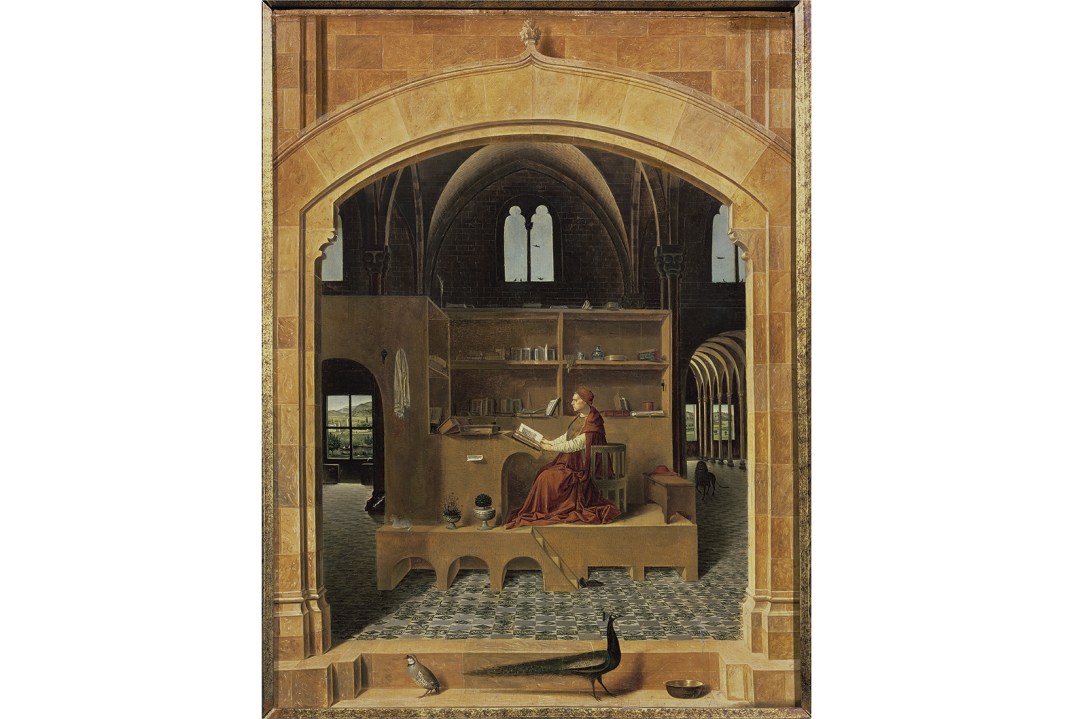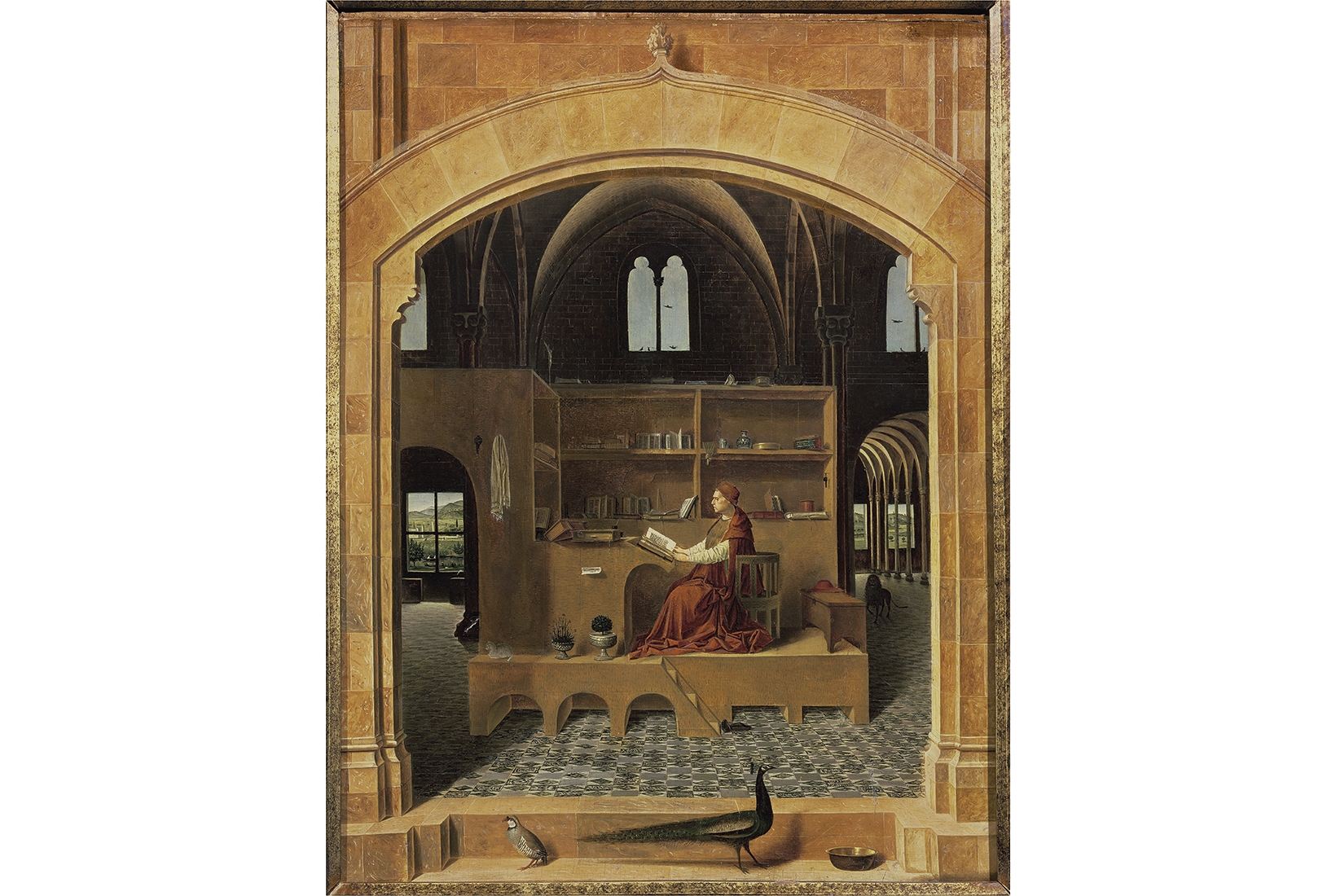Late in the afternoon on Valentine’s Day, I walked through an almost empty Uffizi. Coronavirus was then a Wuhan phenomenon. Our temperatures had been taken at the airport, but there were no restrictions on travel and those wearing masks looked eccentric. I congratulated myself on finding Florence so quiet. Off-season, I thought smugly. That’s the way to do it. Heaven knows it’s empty now.
The painting that caught my eye on that distant-seeming visit was a long, low cassone-shaped painting on the theme of the Thebaid attributed to Fra Angelico (c.1420). The Thebaid is a collection of texts telling of the saints who in the first centuries of Christianity retreated to the barren lands around the Egyptian city of Thebes. In the Uffizi painting we meet a mass of isolates, each man declaring: ‘I want to be alone.’
They crouch in caves, pray on rocky outcrops, immure in huts and make nests in trees. Some prostrate naked under beards that come down to their knees. If at first glance the painting seems almost comically crowded, a wilderness like Piccadilly Circus, once you allow your eye to rest on the scenes in sequence, you discover that each one is discrete, entire and interior. There might be a million miles between them. Extreme social distancing.
We are all holy men and women now. Our way is the way of the ascetic and the anchorite
Six weeks on and we are all holy men and women. Our way is the way of the ascetic and the anchorite. Isolation is glorious if it is sought, but not if it is imposed. Many of us, even those used to the solitude of the study, the man cave, the shed, are lonely and spooked. As flights, trains, meetings, exhibitions, ballets and birthday parties have been cancelled, I have sought solace in images of hermits in the desert and saints in their cells. My sixth-floor flat in Bayswater is far from Thebes, but the gift of art is to allow the mind to wander, even when the body may not.
It is harder to achieve the via contemplativa in the age of rolling news. That’s one virtue of the desert: no wifi. What one needs is a Working From Home hero. I have set Antonello da Messina’s ‘Saint Jerome in His Study’ (c.1475) as my desktop background. Jerome, one of the four fathers of the western church, the scholar who translated the Old and New Testaments into Latin, sits at his desk. Formerly a penitent in the desert, where he removed a thorn from a lion’s paw, we meet Jerome now serenely retired to a spacious cell in Bethlehem.
If you have half an hour to spare — who doesn’t? — have a go at zooming over the picture on the National Gallery website. Every tile and symbol of this sublime puzzle-box painting is revealed: the peacock, which stands for celestial paradise; the cat waiting like the devil to entrap men’s souls; the partridge thought to be so fertile she could conceive, immaculate, by a whisper or a breath of wind. Through the window on the left we see the pull of worldly existence: pleasure boats, a distant city, riders and riverbank walkers. Through the window on the right, above a restless ragtail lion, is the cleansing desert. In the clerestory, birds fly from ledges. As Jerome wrote, quoting Psalm 124: ‘Our soul is escaped as a sparrow out of the snare of the fowlers.’
Jerome’s colonnaded cell is a proper work-in-progress study: books propped, spines bent, ribbons marking places. Vincenzo Catena’s ‘Saint Jerome’ (c.1510), also in the National Gallery collection, is a one-tome-at-a-time man. His tidy cubbyholes hold clasped volumes, candlesticks, flasks and what looks promisingly like a biscuit tin. He seems to be nodding off. But that’s all right. ‘Read often,’ Jerome advised his followers, ‘and learn all you can. Let sleep steal upon you with a book in your hand, and let the sacred page catch your drooping head.’ Jan Van Eyck’s ‘Saint Jerome’ (c.1435) from the Detroit Institute of Arts is a messer. His table is cluttered, his pen leaks on to the cloth. His books are harum-scarum on the highest shelf. In Albrecht Dürer’s engraved ‘Saint Jerome’ (1514), the broad-shouldered saint hunches at a too-small lectern. Think of the Twitter pictures of ironing boards and cocktail cabinets requisitioned for desks. Dürer’s lion and dog doze in a sunny spot. All is quiet concentration. You feel it must be nearly time for tea. In Lucas Cranach the Elder’s ‘Portrait of Cardinal Albrecht of Brandenburg as St Jerome in his Study’ (1525) the mood is more monastic-procrastination. Cardinal Albrecht stares into space. His lion paces. The dog wants walking.
Perhaps the saint we need most today is Saint Anthony the Great, founding father of church monasticism and a figure of saintly healing. When your cough is persistent and the loo roll runs low, it’s Saint Anthony you want for prayers of intercession. You’ll know him by his bell, his tau and his pig. In successive desert fastnesses, Saint Anthony was tormented by visions of money, glory, food and wine. The Devil came to him at night as a beautiful woman and as a young black boy, promising fornication in various forms. He was whipped and beaten by demons, clawed by wolves, bitten by asps and stung by scorpions. Hall’s Dictionary of Subjects and Symbols in Art puts it like this: ‘As might be expected, Anthony’s temptation by Lust has kindled far more artistic imaginations.’ In Jan Brueghel the Younger’s ‘Saint Anthony’, a dole queue of devils assemble. Two beautiful queens stand at Anthony’s shoulder. He raises a hand. ‘Please,’ he might be saying. ‘I’m just trying to read my book.’
Given my perch in the attic, my patron saint should really be Saint Simeon Stylites. Simeon’s life was a series of retreats. In his varied ascetic career, Saint Simeon, a Syrian monk of the early fifth-century, bricked himself up in a hut, chained himself to a rock, lived at the bottom of a well and spent the last 36 years of his life atop a 21 metre-high ruined column in the northern Syrian desert. ‘Stylite’ comes from the Greek ‘stylos’ meaning pillar. Hundreds of pilgrims came to see and (if they could reach) touch him. The British Museum has a small collection of 6th- and 7th-century ‘pilgrims’ tokens’, little souvenirs impressed with images of saints up ladders that were produced at holy sites. The Louvre has a beaten silver plaque, originally part of the treasure of the church of Ma’arrat an Numan in Syria, showing St Simeon sitting cross-legged on a Corinthian capital. A slithering, gilded serpent winds its way up the column.
Pin up postcards round your makeshift desk. Think of the monks in San Marco in Florence, each cell with its own Fra Angelico fresco. Consider cutting a hatch into the front door like those between cell and cloister at the Charterhouse in London. Good for Ocado and Deliveroo. Embrace your inner anchorite. Though within reason. No hedgehog vests, no nettle knickers. No hairshirt, no scourge. No bodily mortification of any sort. Running out of eggs is punishment enough.
I miss my Mum and Dad, self-isolating in Oxfordshire. If not yet Aged Ps, they are certainly not young enough to risk infecting. I wonder if they’d have me as a hermit? In the 18th-century, the great age of folly-building, gentlemen, once they had tired of the Gothic tower and the Doric temple, might commission a rustic hermitage and install a picturesque friar within. I could camp in the bothy at the bottom of the garden. The wifi doesn’t work out there.








Comments